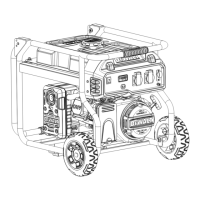17
Checking and Filling Fuel
WARNING!
TO PREVENT SERIOUS INJURY FROM FIRE:
Fill the fuel tank in a well-ventilated area away from ignition sources. If the engine is
hot from use, shut the engine off and wait for it to cool before adding fuel.
Do not smoke.
1. Clean the Fuel Cap and the area around it.
2. Unscrew and remove the Fuel Cap.
3. If needed, fill the Fuel Tank with 87 octane or higher unleaded gasoline.
Note: Do not use gasoline containing more than 10% ethanol (E10). Do not use E85 ethanol.
Note: Do not use gasoline that has been stored in a metal fuel container or a dirty fuel container.
It can cause particles to enter the carburetor, effecting engine performance and/or causing damage.
4. Replace the Fuel Cap.
5. Wipe up any spilled fuel and allow excess to evaporate before starting engine. To prevent FIRE, do not
start the engine while the smell of fuel hangs in the air.
Engine Oil Change
CAUTION! Oil is very hot during operation and can
cause burns. Wait for engine to cool before changing oil.
1. Make sure the engine is stopped and is level.
2. Close the Fuel Valve.
3. Place a drain pan (not included) underneath the crank-
case’s drain plug.
4. Remove the drain plug and, if possible, tilt the crankcase
slightly to help drain the oil out. Recycle used oil.
5. Replace the drain plug and tighten it.
6. Clean the top of the Dipstick and the area around it.
Remove the Dipstick by threading it counter
clockwise, and wipe it off with a clean lint free rag.
7. Add the appropriate type of oil until the oil level is
at the full level. SAE 10W-30 oil is recommended
for general use.
Note: Do not thread the dipstick in when checking the oil level.
The SAE Viscosity Grade chart shows other viscosities to use
in different average temperatures.
10W-30
30
5W-30
-20 0 20 40 60 80 100°F
SAE Viscosity Grades
Average outdoor temperature
8. Thread the dipstick back in clockwise.
will be permanently damaged.
CAUTION! Do not run the engine with too little oil. The engine
Full level
Low level
Full level
Low level

